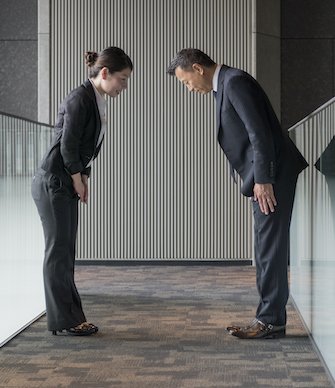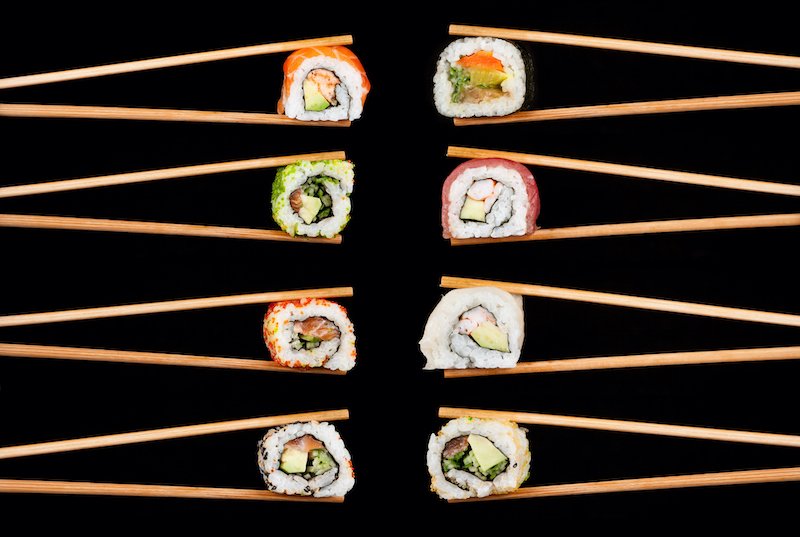Japan is a country that is four big islands and some small ones.
There are big cities in Japan because lots of people live there.
Gardens in Japan are very famous.
Japanese eat their food using chopsticks.
The trains are very fast.
Japan- The land
Japan is made up of four main islands and thousands of smaller ones which lie in the north Pacific Ocean. The four main islands are Hokkaido, Honshu, Kyushu and Shikoku.
Maps courtesy of www.theodora.com/maps, used with permission
Most of the land is covered by mountains and hills and many of the mountains are active volcanoes. There are about 60 active volcanoes in Japan and there are often earthquakes throughout the country.
Mt Fuji at dawn. Getty Images
Japan's most famous mountain is Mount Fujiyama, or Mount Fuji. It is an active volcano about 100 kilometres from Tokyo. It is considered by the Japanese to have an almost perfect shape, and it is the subject of countless paintings and photographs.
Read the kidcyber page:
Thick forests cover many of the mountains. Most of the people live on the flat land in the valleys between the mountains or on the plains near the coast of each island.
Honshu is the island with the largest population. It is linked to Hokkaido by an underground tunnel and to Shikoku and Kyushu across the sea by a series of bridges.
Climate
Japan's climate varies from north to the south. In the south, the winters are mild and the summers are hot. In the north, the winters are cold and snowy, and the summers are mild. All parts of Japan get plenty of rain. Big storms called typhoons often cause floods and damage houses and crops during the summer months from August to October. -
Plants
Most of Japan's mountains are covered with forests of fir, larch and spruce trees. In the south where the weather is warmer, bamboo and camphor trees grow.
Japan is famous for its flowering plants which include azaleas and cherry blossom trees.
A pond in a Japanese garden. Getty Images
There are many festivals that celebrate flowers, such as the spring cherry blossom and the November chrysanthemum festival. The chrysanthemum is Japan's national flower.
There are many national parks in Japan where the people can enjoy the natural beauty of the country.
Wildlife
Brown bears, wolves and deer live in the forests and foxes and badgers, otters, mink and weasels live in many parts of Japan.
Macaque monkeys in a hot pool. ©Getty
The Japanese macaque monkeys live in the forests and on the coasts. They are famous for sitting in the natural hot springs to warm themselves. Macaque monkeys have thick fur that protects them from the cold and snow in winter.
Life in Japan
Tokyo is Japan's capital city. The name means 'eastern capital' and it has been the capital since 1868. About 8 million people live in the centre of the city and it is one of the biggest cities in the world. Millions more people live in suburbs around the city. The people travel to and from the city by train and by car on the city's many expressways.
Night time in a downtown Tokyo street. ©Getty Images
Millions of people work in the city, which is a centre for banking and financial businesses.
In and around Tokyo there are many factories where food is processed, textiles, cameras, electrical goods, computers and other machinery are made. Ships and cars are built and books and chemicals are produced.
Tokyo is a popular destination for tourists and many thousands of people work in hotels, restaurants and other tourist related businesses.
Japanese people greet each other by bowing. ©Getty Images
Japanese people are very polite, and bowing to each other is a way of showing respect when greeting, or saying goodbye or congratulating someone. There are differences in how to bow, and it is so important that it is taught from childhood.
Read about bowing in Japan
https://tokyofamilies.net/2014/12/when-and-how-to-bow-in-japan/
People of Tokyo and other Japanese cities live in small apartments in high-rise buildings. There are also single or double-storey houses with small courtyard gardens. People shop in supermarkets, large department stores and in shopping malls. There are fresh food markets too.
A group of women wearing the traditional kimono. ©Getty Images
Although many business people wear western clothing, the kimono is the traditional dress in Japan and is also frequently worn. The kimono was introduced into Japan by Buddhist monks from china more than 1200 years ago. A kimono is a loose-fitting costume made from silk or cotton. Men, women and children wear the kimono.
Trains that changed train transport around the world - Japan's famous ‘bullet’ trains
A bullet train speeds past Mt Fuji. ©Getty Images
Shinkansen (say shin-kan-sen), often called bullet trains, travel from Tokyo to other Japanese cities. These trains can travel at speeds of up to 320 kilometres per hour. The nickname ‘bullet’ refers to the sleek, streamlined shape of the train that helps its speed.
The first Shinkansen train was opened in 1964, just before Japan’s first Olympic Games. Originally, there were 60 trains each day from Tokyo. Today, there are hundreds, and Shinkansen lines now go to many places across the country.
The Shinkansen trains travel on wider gauge tracks than normal trains, in specially constructed rails and sleepers designed to take stress. For the safety of road traffic and train passengers there are no rail crossings: traffic goes over or under the train line.
Read about the bullet train history, development and facts about their design and construction :
https://www.youtube.com/watch?v=T3LLgzO_PrI
Fishing
Japan has one of the largest fishing industries in the world. Every village on the coast has its own fleet of fishing boats. These big, powerful boats can travel thousands of kilometres to catch fish in the world's oceans. The fish caught include sardines, tuna and salmon.
Japanese also farm fish and shellfish such as oysters.
The oysters kept on some farms are used to make pearls for jewellery. A tiny piece of shell is put into the oyster. The oyster is irritated by the shell and produces a substance called nacre which coats the piece of shell. The oyster coats the shell with many layers of nacre and forms a pearl. The oysters are kept in wire basket to protect them until, after two to three years, it is time to open the shells and harvest the pearls.
Japan:Fact File
Official name: Japan
Capital city: Tokyo Official language: Japanese
Population: 125,541,687 as of Sunday, December 4, 2022
Government: a constitutional monarchy with a parliamentary government, which means the Japanese people vote to elect members of parliament.
Head of government: Prime Minister Head of State: Emperor
Religion: the main religions are Shinto and Buddhism
Area: 377 801 square kilometres.
Highest mountain: Mount Fuji 3776 metres
Money: yen
Agricultural products: rice, pigs, chicken, tea, fruit, tobacco, potatoes, vegetables, fish.
Manufactured goods: electrical goods, cars, machinery, iron and steel products, chemicals, textiles, paper, ship building.
Sports: baseball, volleyball, table- tennis, tennis, skating and basketball are popular Traditional sports are judo, karate, kendo and sumo.
Tokyo, Japan was to host the 2020 Summer Olympic Games but these were postponed for a year because of the Coronavirus pandemic. They were held 23 July - 8 August 2021, although they were still called Tokyo 2020.
Read about the events and results at the Tokyo Olympics
https://olympics.com/en/olympic-games/tokyo-2020
The biggest sport in Japan
Japanese Sumo wrestling is one of the oldest martial arts in Japan. It is many centuries old, but developed into its current form in the 15th century. This means it has many traditions and rituals that are very important, such as the blessing of the circle in which each bout takes place.
Sumo wrestling began as a part of the Shinto religion about 1500 years ago. The wrestling matches were dedicated to the gods in prayers for a good harvest. Wrestlers spend many years in training and in gaining the weight needed to be successful. Champions are major celebrities in Japan.
Sumo wrestling matches begin with a traditional ceremony. The wrestlers, each accompanied by two assistants march in and perform bows, foot stamping to scare away evil spirits and other rituals before the contest begins. Wrestlers then try to push or throw their opponents out of the ring which is known as the dohyo or try to push the opponent down onto the mat. The wrestler who first touches the floor with something other than the soles of his feet or is out of the ring loses.
Read about the rules and practices of Sumo wrestling
https://web-japan.org/kidsweb/virtual/sumo/
Watch a video explaining Sumo
Japanese Food
For Japanese people, the way food looks and is presented is very important. Colours, textures and flavours are carefully balanced, and the choice of plates and bowls is important to the food’s appearance also. There is a large choice and range of meals to choose. A meal may consist of several bowls giving small tastes of a variety of foods including pickles, or it may be a hearty bowl of soup with noodles or stew.
This meal consists of small tastes of several foods, served with rice. ©Getty
Examples of a day's menu:
A Japanese breakfast might include a clear miso (bean curd) soup, some boiled rice and fried egg.
Sushi. Getty Images
Lunch might include noodles and pickled vegetables or sushi which is thin slices of raw fish served in blocks of rice, wrapped in dried seaweed called nori. It may be dipped into soy sauce before being eaten.
Dinner might be a nabemono, which are cooked stews using either fish, seafood, chicken or meat and with or without vegetables. The stew is cooked and served bubbling in its pot at the table and everyone dips in to take a serving.
One special kind of nabemono is beef sukiyaki. It is made with thinly sliced pieces of beef quickly cooked at the table and dipped into raw egg before it is eaten. Nabemono dishes are popular in the cooler months of autumn and winter.
Tempura prawns. ©Getty Images
Tempura might be another choice. Seafood and vegetables are dipped into a light batter of flour, eggs and iced water and then fried quickly in oil.
Sea vegetables are popular foods. They are certain kinds of marine algae (seaweeds) such as kelp, rockweed, gulfweed, and laver. When fresh seaweeds are cooked they taste like salty green vegetables. They can also be dried. Sea vegetables are used in stews and broth, soups and salads. Some are used to wrap sushi and dried fish.
The Japanese drink tea, beer and a wine made from rice known as sake.
Read more about Japanese food, including recipes to try:
http://encyclopedia.kids.net.au/page/ja/Japanese_cuisine
http://www.bento.com/tf-recp.html
Find lots of information about Japan on this kids’ website: use its search engine to look for specific information you want
https://web-japan.org/kidsweb/













